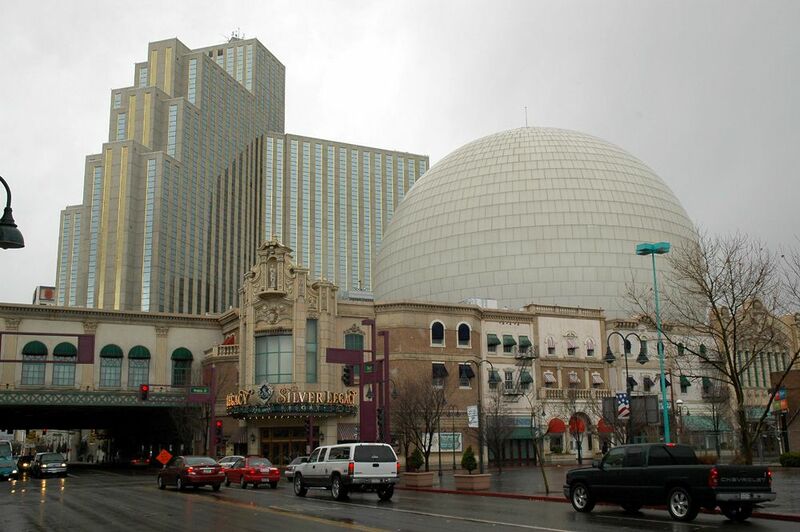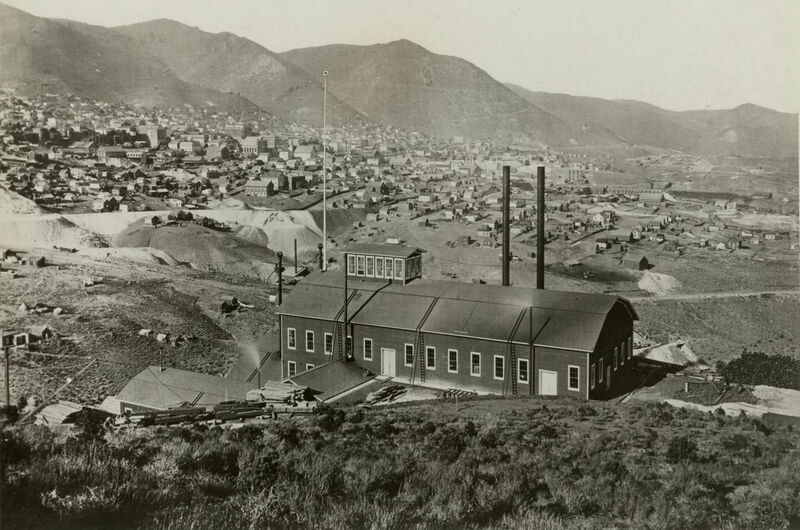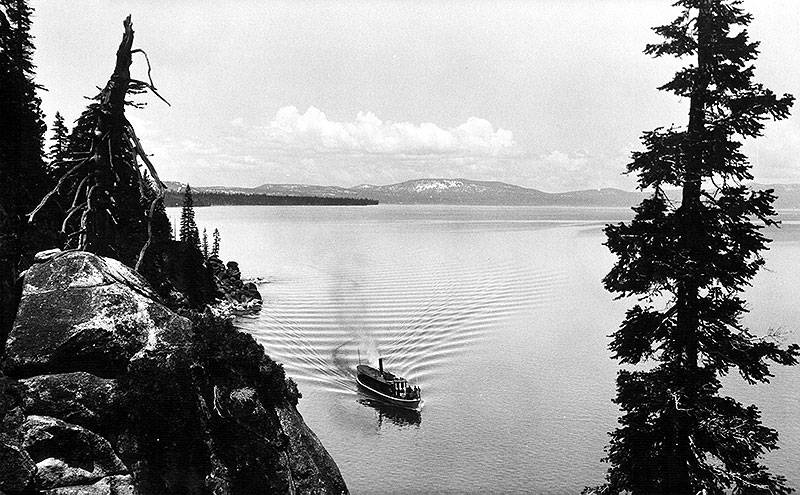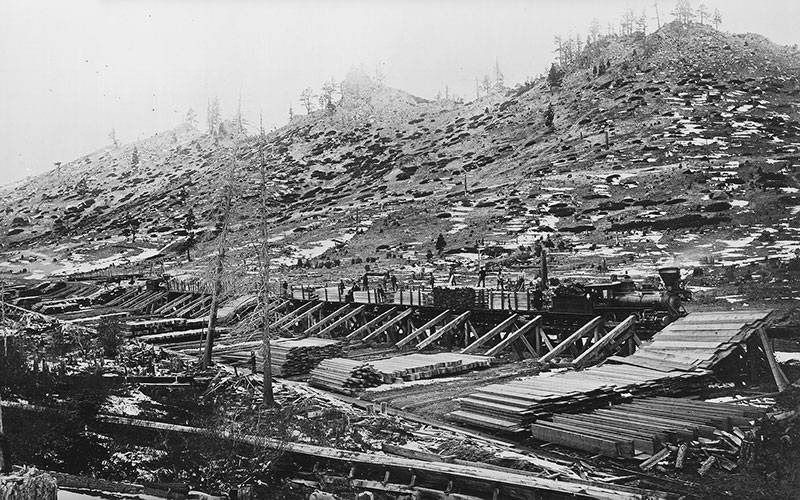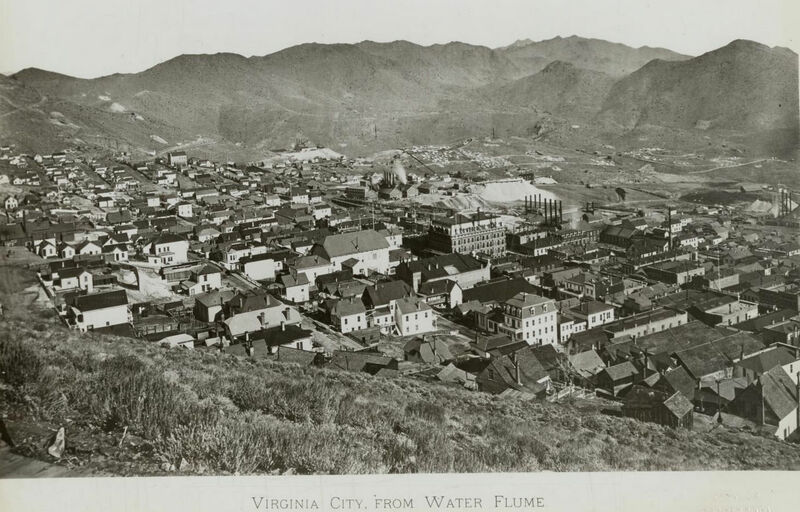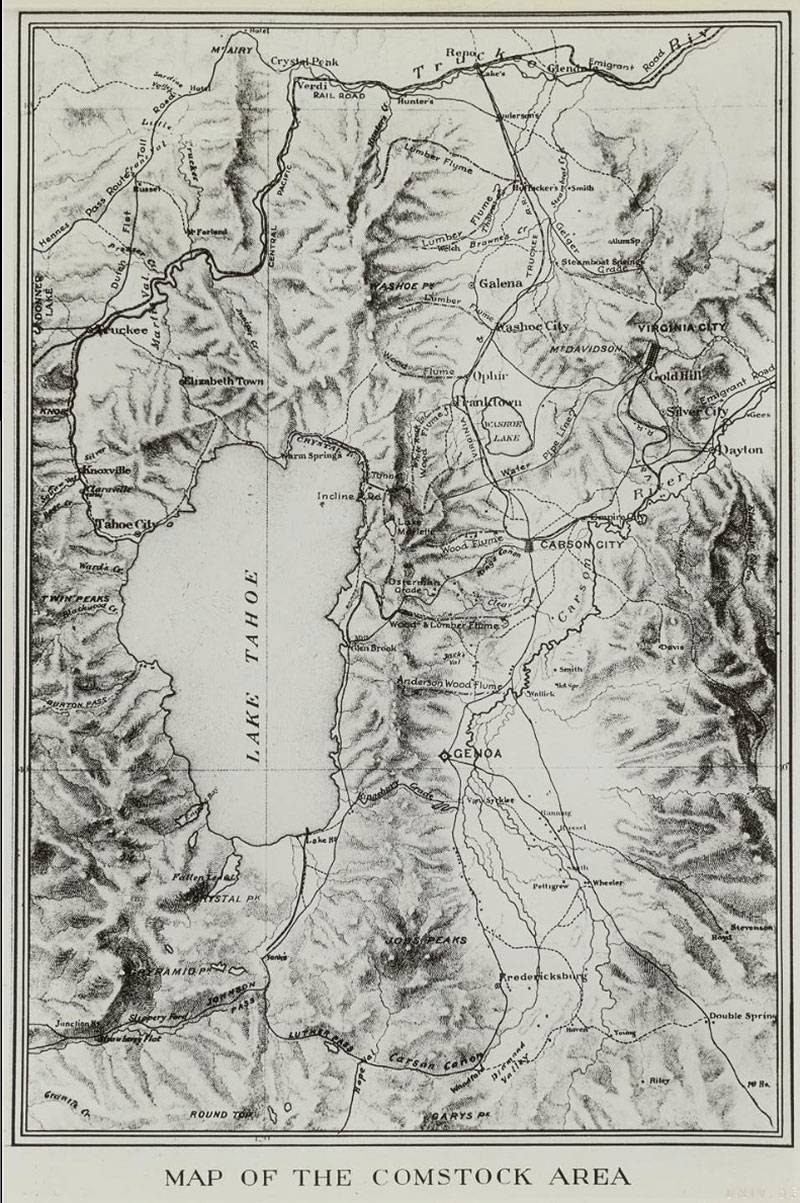Silver Legacy: San Francisco and the Comstock Lode
Historical Essay
by Jon Christensen
Originally published in Reclaiming San Francisco: History • Politics • Culture, City Lights Books: 1998
Virginia City, Nevada, panorama, 1860s.
Photo: Carleton Watkins
Landscapes can be deceptive. Sometimes a landscape seems to be less a setting for the life of its inhabitants than a curtain behind which their struggles, achievements and accidents take place.
—John Berger
The casual San Francisco gambler might be excused for taking the Silver Legacy at face value. The portal of the hotel and casino in Reno, an easy four-hour drive from the Bay Area on Interstate 80, is inscribed “Established 1895.” The facade of the casino is familiar from the sets of TV Westerns. Imagine the TV Western “Bonanza” with a Victorian mining boom-town theme instead of cowboys. A row of stylized storefronts in a Victorian boomtown runs for a block along Virginia Street, Reno’s gambling row.
The Silver Legacy was actually built in 1995. Theme casinos have taken over Las Vegas, but the Silver Legacy is the first of its kind in Reno. The conceit of the Silver Legacy is that a miner named Sam Fairchild built the casino right on top of a great silver mine. Inside the casino a huge stylized mining headframe—a pyramidal scaffold of beams—rises under a great dome upon which the heavens are painted. The colors of the sky shift from day to night and around again every two hours. As the sky darkens, the sounds of whippoorwill and crickets give way to thunder and rain, while the clink, clink, clink of coins in the silver pans of slot machines provides a constant reminder of what this fantasy world is based upon.
Silver Legacy casino, Reno, Nevada.
Photo: courtesy structurae.net
If a legacy is what has come down to us from the past and history is what we think about it, I had come to the Silver Legacy knowing that the history of the silver legacy, whatever it may be, was not likely to be found here. But I thought that maybe through the bald-faced lie of a casino I could begin to measure the distance between the history of this place and its relationship to San Francisco and the legacy that has come down to us. For a silver legacy does truly link northern Nevada—Reno, Carson City, Virginia City, and Lake Tahoe—to San Francisco. People, capital, transportation, construction, labor, and recreation have flowed back and forth for almost 150 years. San Francisco shaped northern Nevada, both as a result of extracting its capital of silver and gold, and as a result of the periphery then shaping itself to exploit the center’s capital through gambling and tourism after the extractive economy of mining went bust.
During a road trip from Reno to San Francisco, I set out to explore the evidence of this legacy on the land I love and to find the historical remnants of our connections. In Virginia City, thirty miles south of the Silver Legacy in Reno, the real Comstock silver mines are said to have made San Francisco into the City in the 1860s and 1870s. “The Comstock,” wrote Grant H. Smith,
lifted California out of a disheartening depression. It rejuvenated San Francisco, which in 1860 was but a ragged little town of fifty-two thousand people. In 1861 more substantial brick buildings were erected there than in all of the preceding years, nor did that growth ever cease. The opportunity for investments in the early years was limited, and nearly all of the profits from the Comstock were invested in San Francisco real estate and the erection of fine buildings.
For some, the City was a kind of shrine to the spirit of the hinterlands. “In beautifying San Francisco, sterile Washoe had come into her own,” wrote George D. Lyman, in Ralston’s Ring: California Plunders the Comstock Lode. But lest this begin to sound suspiciously like the usual lament of a colony that has gone through the expected progression from extraction to dependency, let me acknowledge at the start that this periphery has always been good at luring resources from San Francisco. Mining and gambling have always played to each other’s hands in the relationship between northern Nevada and San Francisco.
While the Gold Rush expressed itself largely as freelance unaccountable anarchy that changed much of the world economy but built little within this region, the silver boom was all about organizing the regional economy. In this, the Silver Legacy stands as a fitting monument to the concentration of capital in a speculative economy that has straddled the Sierra Nevada for more than a century.
Inside the Silver Legacy casino I picked up a brochure that purported to reveal the “secrets of the Silver Baron’s rig.” I sat by a slot machine on a balcony overlooking the headframe that looms over the activity on the casino floor. “In the 1850s, a young prospector named Sam Fairchild journeyed west in search of a dream,” the brochure said. “He found silver, the largest strike ever. But earth does not give up her treasures freely. Silver mining was a difficult and dangerous profession. So Sam enlisted a team of top engineers to design a revolutionary machine to simplify the mining process. The rig you see before you is an exact replica of that machine. Twelve stories high, it stands directly over the site of Sam’s original claim.”
The brochure goes on to explain how the over-stylized machinery of the mine works:
Inside the mining shed, workers load all the raw material into large ore carts. When the ore carts reach the crusher, twenty 300 pound blades crush the massive rock. Then the conveyor belt brings the powdered ore up to the smelter burning continuously at temperatures of up to 1,000 degrees. The liquid silver is poured into silver bars and cooled at the top of the rig. The bars are then sent down the conveyor belt to the coin pavilion and minted into special “Sam” gaming coins. The coins are then dropped from a large funnel into the carousel windows, where they await the lucky winners.
It’s such a great story it begs to be true. Gambling was indeed built on top of mining in Nevada, as this legacy was built on history. This spectacle at the casino hides history in plain view by creating a reassuringly familiar environment for gamblers to fritter away their money in hopes of a payoff. Slot machines ring the bottom of the Silver Baron’s rig. Down in the pit, there is a tumult of people of all walks of life, nationalities, and colors pulling on the slot machines. They’re dressed casually: gray-haired old ladies in polyester, bikers in leather, skiers in lycra, slackers in flannel, gang-bangers in baggy pants. Most of the gamblers in Reno are from northern California, and a great many are from San Francisco. There is a quiet frenzy as they pull the one-armed bandits and watch the wheels of fortune spin.
Of course, the customers are feeding the casino and not the other way around, but this is how it has always been in mining and gambling. Except for the casual style of dress that predominates today, even among high rollers who drop $100 tokens into slot machines while wearing sweats and sneakers, the scene on the casino floor reminds me of descriptions of the San Francisco Stock Exchange in the 1860s when the City was enthralled with the Comstock silver bonanza.
“The ladies were hurrying to the 11 o’clock session of the San Francisco Stock Exchange Board to gamble on Comstock stocks,” wrote Lyman in 1937:
Beautiful ladies with well-turned ankles; tightly laced ladies in rustling black silk; mysterious women in flowing black veils; perfumed women with sparkling eyes, flashing teeth and diamond-studded ears. The prodigious wealth of the Lode and the excitement attending the selling of these mining stocks had weaned them from homes, schoolrooms and the city’s bright lights. Their silks and satins, diamonds and furs all recorded recently lucky encounters with the market. In all their fine black plumage they flitted about the Exchange, picking up “tips” on stocks and ready at a moment’s notice to pounce upon some favorite with all the resources at their command. For Comstocks had been booming.
Some of the beautiful young employees of the casino are paid to stand around in such finery to help customers find their way to the oyster bar or the brewery or the craps pit. But in the casino the only hint of the real history of the silver legacy is a display in the hotel lobby of a Tiffany silver set on loan from the University of Nevada, Reno’s Mackay School of Mines. John Mackay, one of the real Silver Kings, sent one of the first batches of silver from the big bonanza on the Comstock Lode east to Tiffany’s to have a silver serving set made for his wife. (Lewis 1947) Aside from this relatively modest display, the true legacy of the bonanza is hidden from the view of tourists, who are enticed to participate in this fantasy and recycle their money endlessly while capital relentlessly accumulates to the house, as usual.
About thirty miles south of Reno and across a desert mountain range studded with stunted pinyon trees and dusted with snow, lies Virginia City. For a few years in the early 1860s, when the Comstock Lode was in its heady early bonanza days, Virginia City seemed like the center and San Francisco more of a waystation on the periphery. There was a lively exchange between Virginia City and San Francisco when the Comstock was booming and the whole country seemed to be booming with it. Speculators would come up from San Francisco to “see the elephant.” The wagons would also bring oysters and champagne and traveling theater groups to the mountain.
“Everything in Virginia City from timber to banking, except the Washoe zephyr and the arsenic water, had been hauled over the ridge from California; and when a man made a strike on the Comstock his first thought was a palace on one of San Francisco’s hills,” wrote Franklin Walker:
Features of San Francisco life in the fall of 1863 were Washoe silver stocks, Washoe widows, and Washoe journalists. Nearly everyone was speculating in “feet” on the Comstock lode, nearly as many were keeping Washoe widows from being too lonesome for their men across the mountain, and all who read newspapers had heard of the Virginia City Territorial Enterprise’s new humorist Mark Twain.
Virginia City is now a tourist trap that clings tenaciously to the skeleton of the Comstock. The bleached bones of the mining works and rock dumps lie scattered around. The buildings are leaning toward oblivion. Here it seems like the true history of the silver legacy might be comprehensible if one could push through the distracting gauze of T-shirts and candy shops, the old drunks, and the tinny clinking of slot machines. But just barely.
The story of the Comstock is a story of a boomtown that went bust in the late 1870s and ever since then has been looking for a way to promote its history. At first it lived off its own myth. Stock manipulations and hype kept the mines going on paper even if they never produced much more from the ground. By the late 1870s the Comstock never again held San Francisco in its thrall. The Comstock didn’t find a good draw until the postwar tourism boom and “Bonanza,” which featured a studio lot version of Virginia City. This was Virginia City as a cow town, which it never was, but it became a way for the town to link itself with a popular image once again.
The Bonanzas from the Combination Shaft, Virginia City, Nevada.
Photo: Carleton Watkins
Virginia City still underestimates the value of real history. It has the real thing but does its best to cover it up. And if a good fantasy will do better at attracting tourist dollars, well then, by all means. The Ponderosa bar offers an “authentic mine tour.” I went in for a drink and a look around. The bartender said the mine wasn’t open during the winter. Just as well. Later I learned the tunnel in the Ponderosa was dug in the 1970s as a tourist draw. I still wanted to see a real mine, so I went down the hill to the Chollar mine, also closed for the off season, and prevailed upon the owner to open up the mine. Chris Keichler took me 600 feet back into the original heavily timbered six-foot-square tunnel to where miners had once hoisted silver ore from a beehive of tunnels below. Keichler has meticulously preserved and restored this small part of the mine. It is a good place to see the real structure of the mines and to get a view of the technological transformation of the Comstock that was made possible by the infusion of capital from San Francisco. My guide was familiar with all of this history. He not only provided a place where history could be seen, he also gave opinionated recommendations of several books to fill out my understanding. (His favorite authors are Grant Smith, Dan De Quille, Frank Crampton, Eliot Lord, and John Taylor Waldorf.)
Keichler was more comfortable with the actual workings of the mine than with speculating about the speculation that made the mines, Virginia City, and San Francisco. No one knows for sure how much of San Francisco’s capital was sunk into speculative stock scams on the Comstock, but it may have been almost as much as the Comstock contributed to the building of San Francisco.
“Not less than four-fifths of the assessments collected by the mines throughout their history was contributed by stockholders in California and elsewhere,” wrote Grant Smith:
To the people on the Comstock, where money was expended, an “assessment mine” was almost as helpful as one that paid dividends; but they were the victims as well as the beneficiaries of the widespread mania, for they became inveterate stock gamblers. Nearly everybody gambled in mining stocks in those days—and knew that they were gambling. The aim of all was to “beat the game.” The men who won, whether dealers or players, were admired and envied. It was a mark of distinction to be called a “big manipulator.”
Across the street from the Ponderosa bar, in the Territorial Enterprise building, there is a hodgepodge of artifacts and T-shirts, none of which conveys much of the true history of the newspaper. Virginia City claims Mark Twain because that’s where Samuel Clemens first called himself by his pseudonym. He spent a couple years there working for the Territorial Enterprise, which at the time had the largest circulation of any newspaper in the West. But Twain moved quickly—he went on to national prominence in San Francisco and parts beyond. “There was a popular saying that Washoe people hoped to go to San Francisco rather than heaven when they died,” wrote Franklin Walker.
What Twain took from Virginia City was a jaded outlook that would serve him well in America. He never looked back to Washoe, which is what the desert country of western Nevada was known as in those days, so christened by immigrants who took the name from the Indian tribe that spent the summers around Lake Tahoe and wintered in the valleys east of there, where the wagon trains rested before crossing the mountains to California. (DeVoto 1932)
I too felt like going “down below” to San Francisco, as we all must from time to time, to seek a larger view. But first I would stop at Lake Tahoe, which Twain once described as “surely the fairest picture the whole earth affords.” (Twain 1917)
Lake Tahoe, c. 1912.
Photo: courtesy Jim Bell collection
Lake Tahoe lies at the crossroads between the Comstock and San Francisco. Thanks to a geologic miracle and a political accident, Lake Tahoe is the pivot point between California and Nevada. The mountains peak near 10,000 feet, rimming the emerald bowl of what was once some of the clearest water in North America. “The brightest gem in the mountain coronet of those twin queens, the Golden and the Silver States,” as an over-the-top travel writer described it in the 1860s, Lake Tahoe has always been a wayfarer’s refuge and a center of industry between San Francisco and northern Nevada. (Landauer 1996) In the 1860s, the main trail across the Sierra Nevada went by the south shore of Lake Tahoe, where today giant casinos crowd the state line on the Nevada side, and rows of motels, minimalls and second homes stretch around the lake on the California side.
When you travel Highway 50 to Lake Tahoe today, it appears in its large expanse as such a natural respite from artifice that one is hard pressed to see that the scene has been steadily shaped and reshaped as a center for recreation, an escape from civilized San Francisco on the one side and the boomtowns of Nevada on the other. The tourism industry of Lake Tahoe has been constructed in one of the most beautiful natural settings in the world, but there is trouble lurking in the history of this paradise—trouble rooted in its links to San Francisco and the Comstock.
Spooner Ridge, c. 1876. "The Comstock lode . . . the tomb of the forests of the Sierra.
Photo: courtesy Jim Bell Collection
The forests around Tahoe were clear cut in the 1860s and 1870s for the silver mines. “The Comstock lode may truthfully be said to be the tomb of the forests of the Sierras,” wrote Dan De Quille, a contemporary of Twain’s:
Not less than eighty million feet of timber and lumber are annually consumed on the Comstock lode. In a single mine—the Consolidated Virginia—timber is being buried at the rate of six million feet per annum, and in all other mines in like proportion. At the same time about 250,000 cords of wood are consumed. The pine forest of the Sierra Nevada Mountains are drawn upon for everything in the shape of wood or lumber and have been thus drawn upon for many years. For a distance of fifty or sixty miles all the hills of the eastern slope of the Sierras have been to a great extent denuded of trees of every kind—those suitable only for wood as well as those fit for the manufacture of lumber of use in the mines. Already the lumbermen are not only extending their operations to a greater distance north and south along the great mountain range, but are also beginning to reach over to the western slope—over to the California side of the range.
Lake Tahoe has been an illusion straining to maintain itself for more than a century. In the early days the natural setting seemed grand enough to hide any flaws. Industry existed side by side with luxurious resorts for high rollers from the Comstock and San Francisco. The timber industry was part of the landscape of early tourism: as steamers plied the lake with rafts of logs headed for the eastern shore and Virginia City, they also carried sightseers on excursions. The San Francisco Water Company built a dam at the outlet of Lake Tahoe, hoping to find a way to bring more water to the City. It raised the lake level ten feet, but the water never made it west.
Though the denuded forests prevented Lake Tahoe from becoming a national park, and though the second-growth forest is crowded, dead, and dying—a tinderbox waiting to explode—the ravages of tourism have been worse for the lake. (Tahoe Tribune, February 1996) First came the strip motels of the postwar tourism boom, when the automobile and vacationing middle-class families began to dominate the Western landscape. Then came the casino boom of the 1960s, which hasn’t stopped yet. Tourism dominates the lake today.
A huge redevelopment project is demolishing a mile-long stretch of tacky 1950s motels and replacing them with a large-scale “rustic” development that parodies the myth of the West and Lake Tahoe. This is an era of consolidation in the tourism and gambling industries, similar to the consolidation during the last gasp of mining on the Comstock. The myth of the West is subject to further revision for this era’s concentrated capital investments.
The industry wants to make Lake Tahoe attractive to the same kinds of people it exploited in the early days when only the rich could afford to camp out on a long sojourn from the city or the silver mines. But the area is overcrowded and overloaded with sediment from building second homes and roads, and now environmental restoration is necessary to appeal to the rustic sentiments of professionals on vacation.
So the casino tycoons have struck a deal to make peace with environmentalists. Some redevelopment money will go to restore wetlands that will catch sediment. The wetlands will open up more natural-looking space along the shore of the lake. Still, it will take hundreds of years to turn around the water quality of the lake and to restore the forests and wetlands. Central to the makeover is the tourism industry’s discouragement of lower-class tourism, which is bad for Lake Tahoe’s image and doesn’t bring in much revenue.
The efforts to redevelop in an upscale way mask the fact that Lake Tahoe, while it is the wealthiest region of the Sierra Nevada (and one of the wealthiest in California and Nevada), has the greatest gap between rich and poor. On a drive around the lake, one sees gated communities containing the mansions of the scions of San Francisco and of Nevada casino moguls, while dilapidated apartments are the homes of Mexican families who live and sleep in shifts when they’re not working in the casinos. Tahoe still hides what makes it possible.
I went on to San Francisco to search out the silver legacy at the center, knowing that there is little left. San Francisco has also been adept at turning itself inside out for speculation and redevelopment. “By 1864, the Comstock comet was blazing full blast across the Western horizon,” wrote Lyman:
Unmindful of her maritime past, San Francisco had become a mining city and had plunged wholeheartedly into a gambling mania, the like of which had never before been known on the coast. With millions of dollars in bullion in sight on Sun Mountain, Californians had thoughts for nothing but the stock market. As millions of dollars of San Francisco money were invested in Washoe hoisting machinery and reduction works, corporate organizations had been formed in San Francisco to which the mining claims were sold or exchanged for shares of stocks.
“The Comstock mines early became a synonym for stock devilment, for which the brokers and manipulators in San Francisco have been held solely responsible,” wrote Smith. “True, theirs is the chief responsibility, but the gambling public must bear its share of the blame. The system early developed from a speculative investment in mining stocks into a gamble—then into a lottery.”
“In flush times the leaders of stock operations were known by their purple and fine linen, their splendid equipages, and their lavish expenditures, generally in San Francisco, but sometimes in a trail of coruscating glory across the continent,” wrote historian Charles Shinn.
“There were three active stock exchanges in San Francisco during the flush ’70s, each with a large membership,” wrote Smith:
Able and daring men gravitated to them by instinct. They were the liveliest places on the Coast and the focus of public attention. When “Jot” Travis, a well-known westerner, was being shown about the waterfront of San Francisco in the late ’70s and one fine yacht after another was pointed out as belonging to a wealthy stockbroker, he finally inquired, with an air of childlike innocence, “W-where are the c-customers’ yachts?”
Certificates of stock became tickets, and the holders won or lost on the turn of the wheel, wrote historian Eliot Lord. “A few prominent capitalists purchase the control of mines for the sake of dividends, and the profits of milling ore, but the great body of holders bought their shares to sell at an advanced price.”
“A well-managed ‘stock deal’ was as acceptable to most holders as an actual development of ore,” Smith concluded, in what is probably the most accurate accounting of the true history of the silver legacy:
Control was often bought and utilized for the purposes of “rigging the market” and for the salaries, luxurious offices in San Francisco, and other perquisites that opportunity afforded. It should be said, however, that if San Franciscans milked the Comstock, they also fed it.
Calculating a final balance sheet for the Comstock, Smith estimated that from 1859–1882, the mines produced $320 million in silver and gold. Dividends totaling around $125 million were paid out to stockholders and around $74 million was invested in the form of assessments on stockholders for developing the mines. Smith estimated that private profits were not less than $20 million.
Virginia City from water flume, 1870s.
Photo: Carleton Watkins
Yet today little remains. The mansions of the Silver Kings, the mining offices, the stock exchanges, and the newspapers that chronicled those days are either gone or remain as mere shells of their former selves, like the the Bank of California. Redevelopment is transforming San Francisco from the inside out while some of the historical shells are preserved. Some fading signs on the sides of buildings give a romantic air to the City that was, while the remnants of an old economy are transformed to serve the new.
It’s hard to find stable reference points in a landscape that is constantly being remade. The center and the periphery are two parts of a self-reflecting fantasy. We want a comfortable history in which to sell the past. In northern Nevada, we fret about “Californication,” in a titillating way. The Reno News & Review, the local weekly alternative paper, recently worried, “Are Californians Ruining Reno?” The paper is owned by a chain based in California. We don’t have to leave Reno to feel connected to San Francisco. Going back home to Reno from the City, coming out of the mountains into town, I see a series of billboards advertising the restaurants in Harrah’s casino: “It’s like Fisherman’s Wharf. It’s like Chinatown. It’s like Little Italy.”
The shared history of San Francisco and Northern Nevada has become a legacy of speculation. Extractive industries have evolved to mine the imagination. In the process, they bury historical understanding in layers of fantasy, like the Silver Legacy. What begins in the glory of grand speculation ends in the endless grind of recycled images. Everywhere the real ties are obscured and mystified by a promotional and speculative economy that creates a legacy out of our history and throws it in our faces as if to say, “All that matters is what sells.”
Comstock area map, east of Lake Tahoe on California/Nevada border.
courtesy Society of California Pioneers via the Internet Archive
References
Berger, John. 1967. A Fortunate Man: The Story of a Country Doctor. New York: Pantheon Books.
Crampton, Frank A. 1956. Deep Enough: A Working Stiff in the Western Mines. Denver: Sage. Norman: University of Oklahoma Press.
De Quille, Dan (William Wright). 1876. The Big Bonanza: An Authentic Account of the Discovery, History, and Working of the World-Renowned Comstock Lode of Nevada. Hartford, Conn.: Nevada Publications. Reprint: New York: Alfred A. Knopf, 1947.
De Voto, Bernard. 1932. Mark Twain’s America. Moscow, Idaho: University of Idaho Press.
Landauer, Lyndall Baker. 1996. The Mountain Sea: A History of Lake Tahoe. Honolulu, Hawaii: Flying Cloud Press.
Lewis, Oscar. 1947. Silver Kings. New York: Alfred A. Knopf.
Lord, Elliot. 1883. Comstock Mining and Miners. Reprint: Berkeley, CA: Howell-North, 1959.
Lyman, George D. 1937. Ralston’s Ring: California Plunders the Comstock Lode. New York: Charles Scribner’s Sons.
Shinn, Charles Howard. 1896. Story of the Mine. Reprint: Reno: University of Nevada Press, 1979.
Smith, Grant. 1943. History of the Comstock Lode. Reno, Nev.: Nevada Bureau of Mines, University of Nevada.
Twain, Mark. 1972. Roughing It. Berkeley, California: University of California Press.
Waldorf, John Taylor. 1970. A Kid on the Comstock. Palo Alto, California: American West Publishing.
Walker, Franklin. 1938. The Washoe Giant in San Francisco. San Francisco: George Fields.


